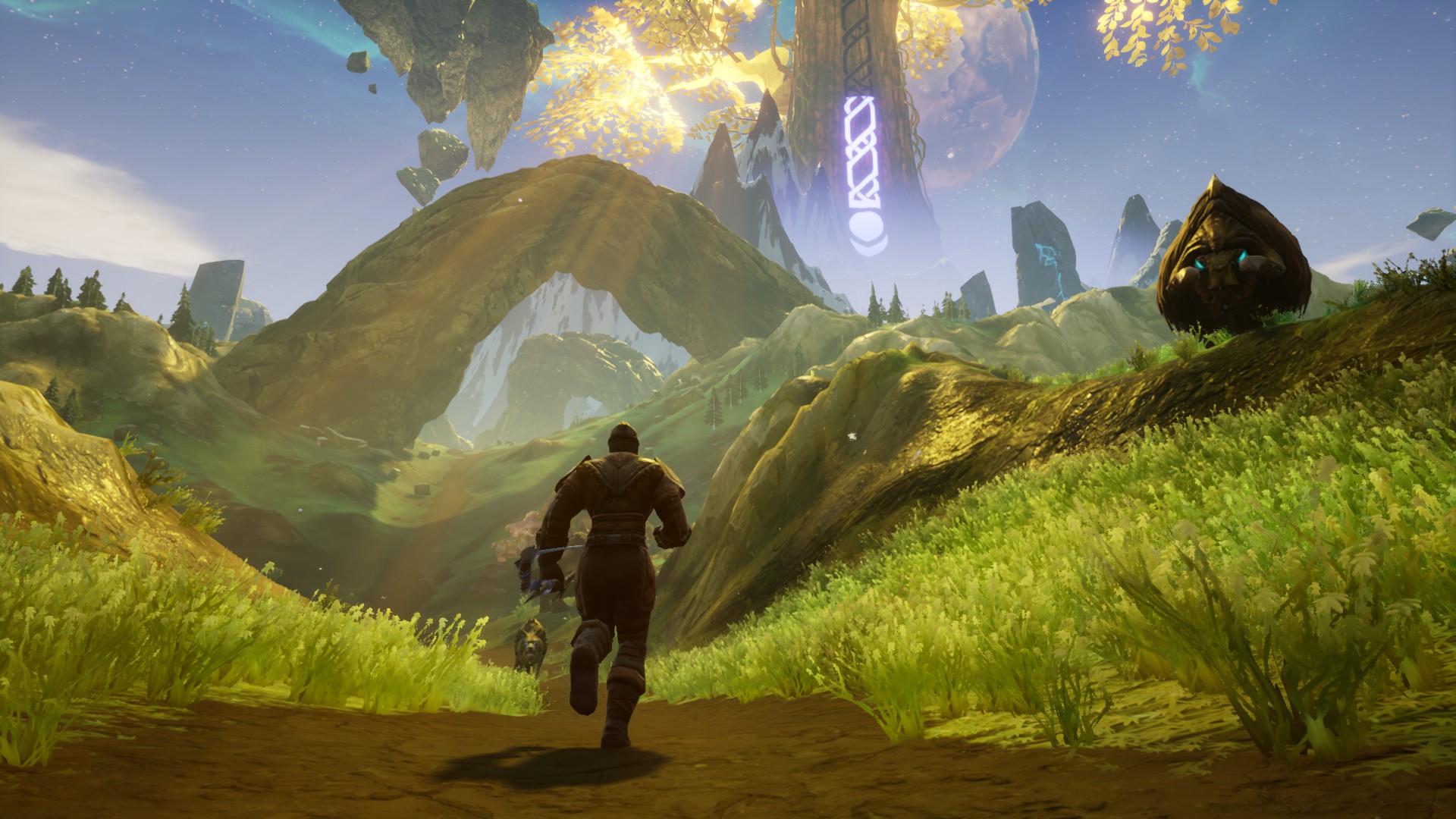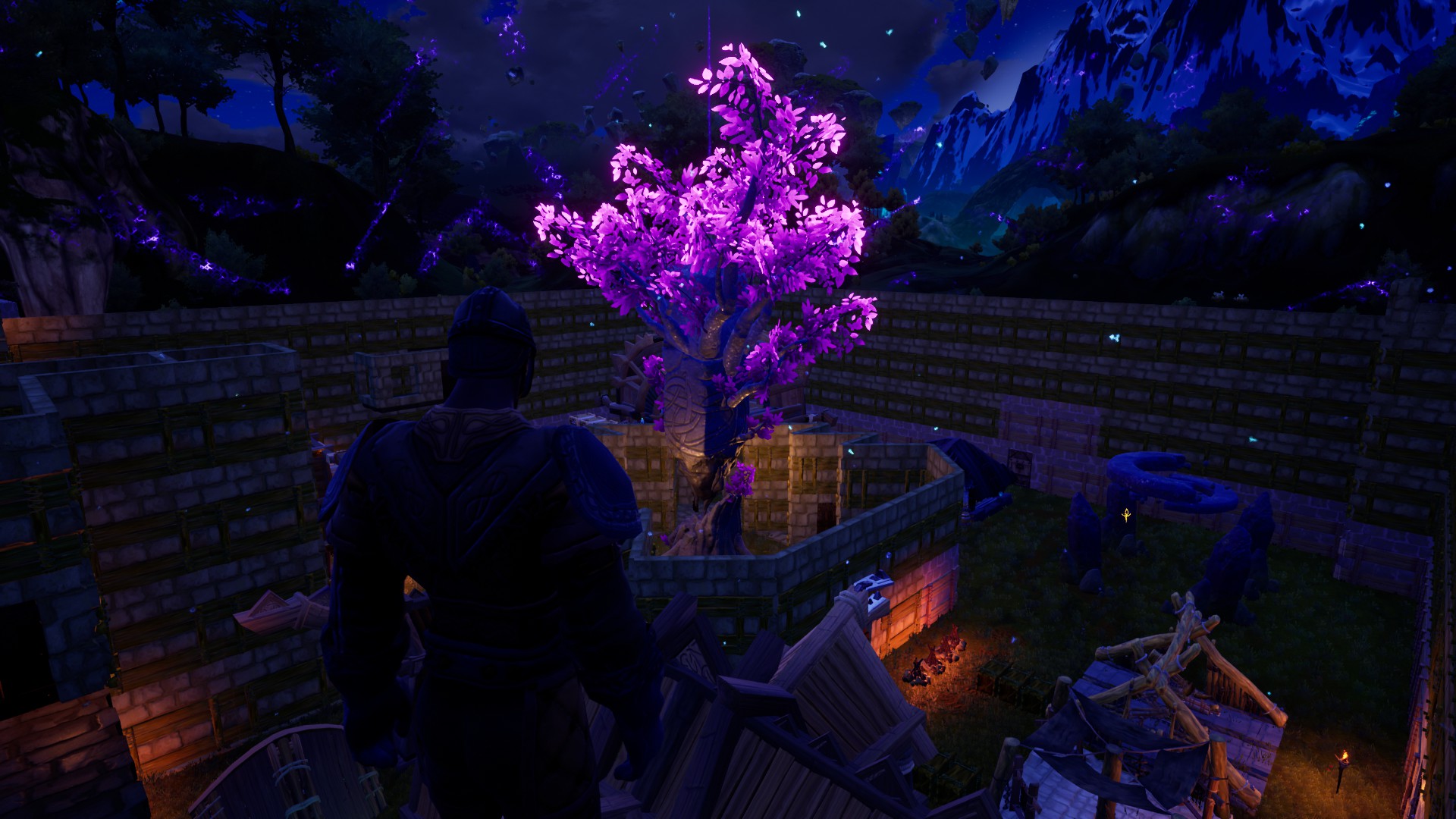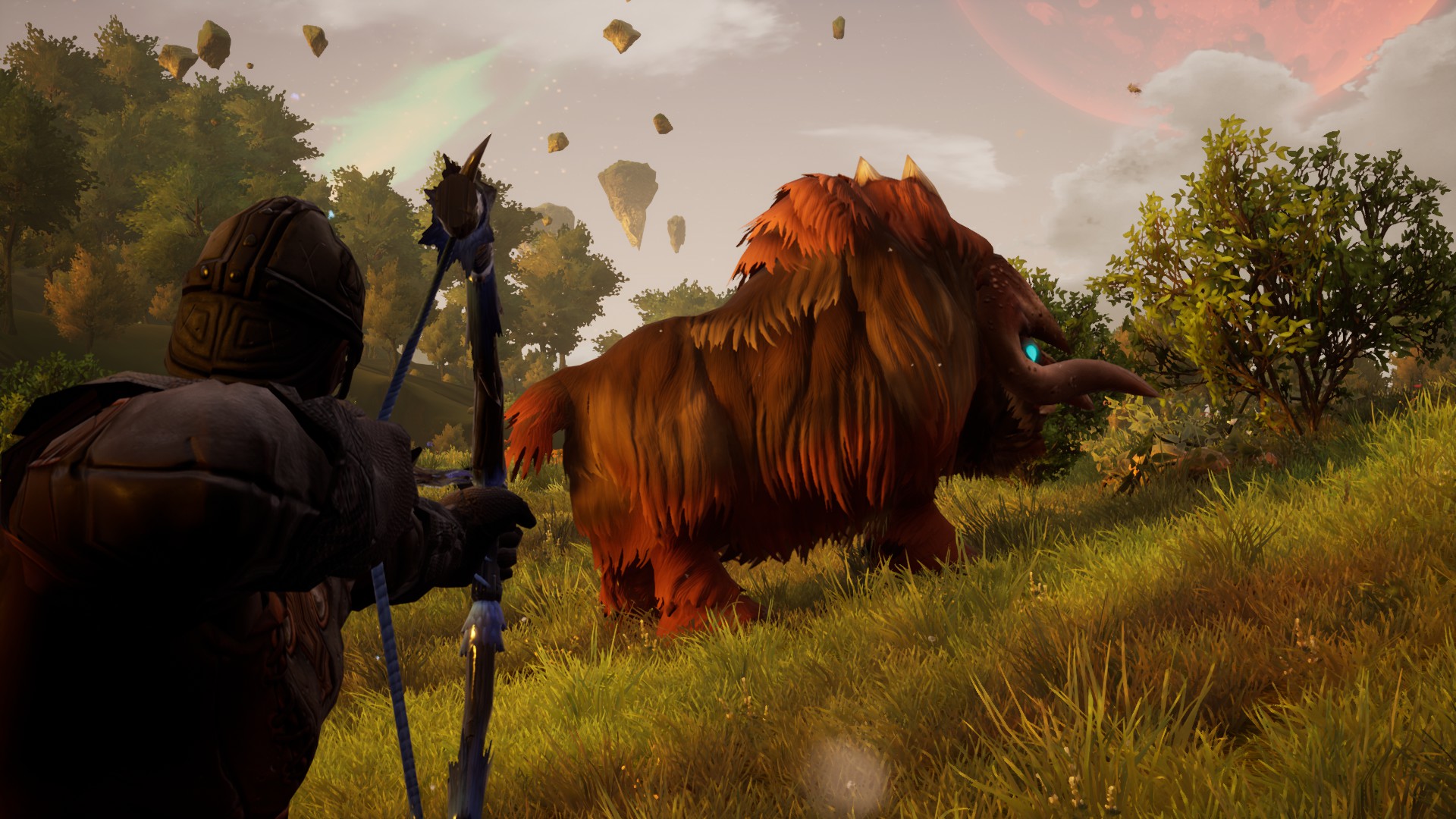Preparing for Rend's apocalyptic PvP events is a lot more fun than fighting in them
It's a promising competitive survival game, but Rend's combat is a mess.
I was minding my own business, building a handsome tower on the cliff that overlooked my factions headquarters, when I was suddenly conscripted into a spirit war. Hearthhome, Rend's most easy-going area, was quiet for now. But the multiplayer survival game was about to turn into a ghost-infested war zone, and each competing faction was battening down the hatches.
The Reckoning, as it's called, occurs every week. For one hour, the skies over the magical Nordic world turn red, the shields around each of the three competing faction headquarters come down, and monsters pour out of the spirit realm to begin their siege. Their goal? Stealing the souls contained within our Divinity Stone—the magical scorecard that measures each faction's progress. But defeating these otherworldly invaders is only half the battle. With the shields down, each base can be wiped out by enemy players. It's prime PvP time.
Rend is pleasantly collaborative and working with your faction is genuinely rewarding, but I’m less convinced by the invasions and PvP.
That's the basic premise for Rend, an Early Access competitive sandbox game where three factions of 20 players battle over the course of weeks. The first to deposit (and protect) the requisite number of spirits in their base's Divinity Stone becomes the victor and then the server is wiped and the cycle starts again from scratch. But getting to that point will require weeks of coordination by every member on that team—especially if you want to survive the weekly Reckoning. Rend is pleasantly collaborative and working with your faction is genuinely rewarding, but I’m less convinced by the invasions and PvP.
Valhalla for crafters
With only an hour until the cataclysm kicked off, everyone in the Revenant—their preference for purple making them objectively the best faction—had dropped what they were doing to prepare. The chat started filling up with a list of resources we had and things we still needed. We fanned out, foraging and hunting, bringing back raw materials that other players would use to make barricades, weapons, and armour.
There's a lot someone can do on their own but beyond the basic tools for survival, it can take a long time to make headway. Just gathering the resources needed to make some simple leather armour can take an hour, and to build the crafting station required to make more advanced armour could take you even longer. The goal of Rend, contrary to a lot of other survival games, isn't self-sufficiency. You're expected to rely on other people and work as a team to fill up your Divinity Stone before the other two factions.

When I joined the server, it was already a couple of days old. After muddling my way through a vague tutorial, I reached the point where I needed to start building things before I could craft better equipment. The crafting menu is dense and there are so many crafting stations, buildings, magical items, and unexplained systems to wrap your head around that it can be tricky to plan your first post-tutorial step. Conveniently, that was also the moment where I spotted our headquarters in the distance. Two days before, it would have been an empty plot of land with a tree in the middle, but members of my team had already transformed it into an indomitable fortress with high walls protecting plenty of buildings and crafting stations.
Stepping into that base was when Rend opened up. All of a sudden I had access to better equipment, all crafted by other players, as well as ways to make all sorts of items for myself. There was a forge, a lumber mill, looms—things that would have taken me days to make myself. Not being responsible for absolutely everything freed me up to specialize. I decided I wanted to be the wood dude. Want some timber? Need a bow? Just holler.
Keep up to date with the most important stories and the best deals, as picked by the PC Gamer team.
I have spent a lot of time in the woods, then. The hours spent hacking away at trees have been made considerably more palatable thanks to the fact that Rend is an uncommonly pretty survival game. Hearthhome in particular is stunning: A vibrant, lively grassland full of warm, sunny days and nights bathed in magical moonlight. When you're not being chased by giant wolves and nasty toads, nature hikes can be wonderfully soothing.
When traipsing around the wilderness on my own, Rend doesn't deviate much from the typical survival formula. I still need to eat and drink. I've also got a stamina meter to keep me from running all the time and I can only carry so much before I become over-encumbered. There are some cool innovations, however. When you're gathering resources, for instance, whether it's wood from trees or animal parts from your latest hunt, the button you press to harvest the resources determines the kind of things you'll receive. For example, left-clicking on an animal carcass while using the axe gives you meat, while right-clicking produces leather.

As our server hurtled towards the Reckoning, I deposited all the wood I'd stocked up over the previous couple of days into shared stashes inside our base. We needed it to finish the imposing spiked barricade surrounding the fortress. The wood was the easy part, though. We also needed some much rarer items. For the rope to bind the wood together, we needed a giant pile of tensile vines, probably the first resource players will struggle to find.
Tensile vines are needed, in small number, for a few early items that the tutorial directs you to craft, but it neither mentions how to gather them or that they're rare. Even when you find the right source, which is just a regular bush, you might think that you're searching in the wrong place because they take so long to discover. Thankfully, gathering rare resources, just like everything else in Rend, is something you get better at with time.
As I did my thing, fighting, foraging, and fixing up my base, I gained general experience that increased my level, experience specific to the skills that I was using and ascension points that are permanent upgrades that can be imported to new characters. It's a complicated progression system, even before you include things like faction-wide research projects and my skill at crafting specific items.
Since I'd picked the Pathfinder as one of my two classes, I was able to invest in talents that were particularly handy for a wild man of the woods. Similarly, all that time spent chopping down trees and picking flowers had increased my botany and woodcraft skills, letting me pick bonuses to things like gathering speed. The result was that, by the time we were desperate for tensile vines, I was plucking them out of nearly every bush.
Rend simply doesn’t do a great job of explaining even its basic systems. You’re just expected to know that gathering is determined by RNG or which button nets you what resource. Failing that you can ask for help. Players pick up a lot of the slack, but they shouldn’t be responsible for teaching every fresh-faced survivor. The latest update provides some more clarity both when it comes to crafting and gathering, but it’s still a bit obtuse for a game where you’re ostensibly in a race. You don’t have time to be aimlessly swiping at a bush and wondering if you’re doing the right thing.

Lost cause
We were as ready as we'd ever be, and 20 of us gathered around the Divinity Stone, the vulnerable heart of our base, waiting for the Reckoning to begin. There'd been so much build-up, so much preparation—and then we sort of just stood around for the better part of an hour.
The spectral monsters, the Lost, appeared on cue. Under the red moonlight, they slowly shambled over to our walls, where they promptly bumped into our barricades and got riddled with arrows. They didn't stand a chance, and the battle couldn't have lasted for more than ten minutes. What a waste of tensile vines. Reckonings ramp up in difficulty over the weeks, which isn’t clearly communicated, but after all the work we’d put in to getting ready, it couldn’t have been more anticlimactic than this minor scuffle. We still had the other players to worry about, of course.
At first, they sent in their spies. Enemy warriors scouted out our base from the safety of the spirit realm—a deadly alternate dimension where players can take shortcuts, tame animal spirits and turn them into mounts, and can only be harmed by other spirit-realm walkers. Rather than waiting for the spies' allies to reach our base, we marched north to meet them. In the Highlands just beyond Hearthhome, we made our stand. Unfortunately, PvP in Rend is a bit of a mess.
Even though you've got axes and hammers for harvesting, Rend's player combat is fought exclusively by using ranged weapons. You can craft bows, repeaters, crossbows, and eventually beefier spike launchers, but everything I've gotten my hands on feels like a BB gun. Nothing has any weight. Bows are the most common weapon, but the arrows have no arc and you have no control over power or range—you just point and shoot. Fights devolve into a mess of warriors jumping and chasing each other as they spray arrows and bolts.

We pushed our enemies back to a small building they'd constructed just before the Reckoning, and that's when the battle petered out. See, they had a special object called a Divinity Seed in there with them, which not only let them respawn, it also allowed other members of the faction to teleport to that location. We didn't have anything that could break down the walls. For that, we needed siege hammers, and we were still waiting for our crafters to finish them.
For the next 30 minutes, half of us got the hammers ready, while the other half surrounded the building, killing anyone that opened the door. Finally, our allies arrived with gifts, letting us get to work. Our hammers chipped away at the walls at an agonisingly slow pace, only for them to be immediately repaired. We were undone by a bug. We gave up. The Reckoning was over.
It was haphazard. Some of it was down to the server being new. None of the factions were really in a position to be conducting a big siege. Given that a cycle lasts for weeks, it would be a shame for a faction to be knocked out before the first one was even over. But that also defangs what's meant to be an apocalyptic event. Ultimately, it was just a bit dull.
It's like being on the ground floor of a strategy game, with everyone becoming an integral link in supply and manufacturing chains.
I still enjoyed working away with my faction, even when we were getting nowhere with our miniature siege. It's like being on the ground floor of a strategy game, with everyone becoming an integral link in supply and manufacturing chains. That time it didn't pay off, but teamwork has also given us our nifty fortress, which recently got upgraded with some mean-looking ballistae, and a seemingly infinite supply of bows. I might not stick around to see my faction win or lose, but I have been popping back in to keep us rich in fine timber. And now that we’re beefier and further along, Reckonings promise to be a bit more exciting—I want to see at least one proper siege.
The flashy invasions and PvP sieges seem like Rend's biggest draw, but the social, cooperative stuff is where you'll end up spending most of your time. That's where Rend seems most in its comfort zone. Watching the world evolve and all these group projects come together is infinitely more rewarding than trying to stick an arrow in someone.

Fraser is the UK online editor and has actually met The Internet in person. With over a decade of experience, he's been around the block a few times, serving as a freelancer, news editor and prolific reviewer. Strategy games have been a 30-year-long obsession, from tiny RTSs to sprawling political sims, and he never turns down the chance to rave about Total War or Crusader Kings. He's also been known to set up shop in the latest MMO and likes to wind down with an endlessly deep, systemic RPG. These days, when he's not editing, he can usually be found writing features that are 1,000 words too long or talking about his dog.

